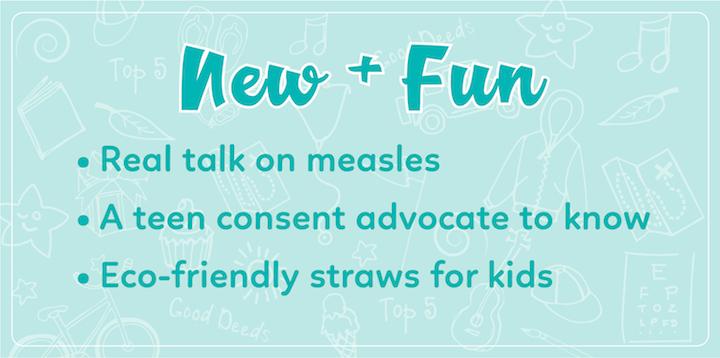
Published as Play Room in the April 2019 issue of PDX Parent
Kid to Know: Irie Page 2.0

Last year we highlighted the work of 15-year-old Irie Page as she organized a super successful community talk on consent for teens. This year the Southeast Portland teen has teamed up with six other teens to form the Coalition For Consent Education (CFCE). Their goal is to build a culture of consent, one conversation at a time. Since April is Sexual Assault Awareness Month, they decided to roll out a series of events to get teens, parents and even younger kids talking about consent. Saturday, April 6 is a teen pop-up dance party/benefit at the Polish Hall on North Interstate. Tickets are $15 in advance. On April 13, one of our favorite entertainers, Penny’s Puppets, will present a show for preschoolers to third graders called “From My Head to My Toes, It’s My Body” at the Portland Waldorf School in Milwaukie. The puppet show aims to empower children about their rights around personal boundaries. And Page and her crew are bringing back consent educator Mike Domitrz for a free talk at PCC Sylvania on April 27. Purchase tickets and get more details at facebook.com/CoalitionForConsentEducation/ — Denise Castañon
Good Deeds: Foster Hope

Nothing about being a kid in foster care is easy. The folks at Portland-based nonprofit Project Lemonade can’t turn all of those lemons into you-know-what, but they can — and do — help make life a little less turbulent by providing an annual free shopping spree for foster youth at their storefront at the Lloyd Center in Northeast Portland. Kids can get the autonomy and dignity of shopping for their own outfits, accessories and shoes from the store’s selection of new and gently used gear. Everyone gets a package of brand-new underwear and socks, too. Kids work from a checklist of items, and there are even personal shoppers on hand to help them find the right fit. “The focus is on the shopping experience and giving youth the ability to find something that makes them feel good about themselves,” says Program Director Lindsay McDonnell. So, how can your family help? Not only can you donate clothes in new (or like new) condition, but you can run a clothing drive at your preschool, school or community organization, or volunteer with older kids to help get things in order at the store for their shopping events. That means inventorying new merchandise, tagging clothing and sorting donations. Ready to sign up to help out? Get in touch at volunteer@projectlemonadepdx.org. — Julia Silverman
Chalkboard: The Last Straw

Kids love straws. And let’s face it — straws make it way less likely that they will spill all over the place, multiple times per meal. But in the last few years, environmental activists have been sounding the alarm over the incredibly negative impact that disposable, single-use plastic items like straws have on the environment and on marine life in particular. According to the Portland chapter of the Surfrider Foundation, straws are among the most common litter picked up during beach clean-ups. Now the powers that be in Portland are listening. A new ordinance passed just a few months ago mandates that customers need to ask for straws and plastic cutlery when out to eat — in other words, goodbye to the days when a straw came automatically with your super-sized drink at the drive-through window. Already, plastic straws are being phased out at some of our favorite kid-friendly pit stops around the city, from ¿Por Qué No? Taqueria to the Portland Spirit’s Willamette River cruises. So what’s an environmentally conscious parent with young kids to do? There’s a solution: Reusable straws. They come in everything from stainless steel to bamboo to glass, and are easily tucked into a diaper bag or tote. (See Gear Guide for our top picks.) Straw for your kids, less plastic waste for the planet. Win-win! (Want to do more? Email ditchthestraw@portland.surfrider.org to learn how you can volunteer for clean-up days.) — J.S.
Gear Guide: Straw Poll
Buluh Straws This set of eight organic bamboo drinking straws comes with a cleaning brush and its own carrying bag. Bonus: kids can’t break the super-strong bamboo. From $12.99 at Amazon.com.
Softy Straws Made from silicone, these reusable straws have that fun bendy quality that kiddos love, and they are BPA-free and dishwasher safe. Testers note that these are especially good for special-needs kiddos, who like to chew on their straws, as they are soft enough that kids won’t cut their teeth, but rigid enough that they won’t tear. $11.99 at Amazon.com.
Klean Kanteen stainless steel straws A best of both worlds situation: These have flexible and removable silicon tips and strong stainless steel bodies. Equally good for hot chocolate or smoothies! $9.99 at New Seasons Market. — J.S.
Playlist: Mexican Treats
When I was a little girl, going to the panadería with my dad was a highlight of the weekend. I’d ogle the colorful Mexican pastries behind the glass case and we’d bring home pink, crumbly polvorones, swirly topped conchas and little breads shaped like pigs. Lucky Diaz and Alisha Gaddis capture the experience of a Mexican-American childhood on their new album Buenos Diaz, under the rebranded name The Lucky Band. Clearly, the song about my favorite Mexican pastries, Pan Dulce, struck a strong nostalgia chord for me. When I pointed out to my son Cruz that Lucky Diaz had a new song about pan dulce, he made the universal kid sign for something delicious — stuck out his tongue and said, “Mmmmm.” Even if you or your kids haven’t experienced a bi-cultural childhood, lively musicianship and effortlessly bilingual gems make this album a keeper. The funky dance beats of Como Se Dice and Mix It Up will make you want to put on your boogie shoes. And the fun, surf-pop tune Taco Tuesday celebrates everyone’s favorite meal of the week. — D.C.
Ask Dr. Doug

Q: The outbreak of measles in Clark County has me feeling terrified about taking my baby into public spaces where she might encounter lots of kids, since she is too young to get the vaccine. Any advice on how to handle this?
A: I hear you. Who would have thought we’d be living through an outbreak of a potentially deadly, but completely preventable disease?
Your daughter is a perfect example of why it’s important to maintain something called “community immunity.” For us Pacific Northwesterners, I like the example of kindling to explain this. When we’re starting a fire, if we have mostly wet wood — even if one piece of kindling burns — it’s probably not going to catch the rest of the pile on fire. However, if enough pieces are dry, then that fire can jump from one piece to the next, and the spread continues and the fire grows.
Measles is the same. It’s incredibly contagious. It can live hanging out in the air for up to 2 hours after the infected person has left a room. And if you are exposed and not immune, you have a 90 percent chance of getting full-blown measles.
Unfortunately, I’ve heard older family members say, “We all got measles when we were kids, and we turned out fine.” To them, I say “Congratulations; you survived to be able to tell us that.” Other than feeling miserable and spreading it, in most cases, measles does get better. But there are serious consequences that can happen, like ear infections, pneumonia, a dangerous swelling around the brain that can cause deafness and brain damage, and even nerve problems that show up years after an infection. And on average, 1 in 1,000 children infected with measles will die.
So here’s the good news — vaccination against measles is safe and it works. It’s important to realize that immunizations in kids are the most studied interventions we have in pediatrics. They have been proven safe in large studies with thousands of children, over and over again, year after year.
The normal ages to receive your MMR is at 12 months old and 4 years old. Almost all children will make enough antibodies after the first shot to be immune, and the rest will make enough after the second shot.
I worry the most about children who are too young to get immunized, or who have immune deficiencies or cancer, and are not able to get the vaccine. They are at a much higher risk of infection and complications.
The other thing I have seen on social media is to give your child megadoses of vitamin A to “prevent” measles if you don’t want to vaccinate. This is 100 percent false. In the developing world, where vitamin deficiencies are pervasive, it’s true that giving vitamin A when you’re fighting off measles may prevent severe complications. It does not keep you from getting measles, and in the United States it will not make you less likely to have complications.
Things you can do now with your daughter: Talk to your pediatrician about whether it makes sense to immunize early based on where you live, her age, and your comfort level. Remember you still need 2 doses of MMR starting at 12 months even if you get one early. Breastfeeding can be protective. If she’s in day care, ask about their policies on vaccination. And when you see or hear information on vaccination that is misguided and not evidence-based, speak up.
We are all good parents, doing the best we can. This absolutely includes parents who decide not to immunize their children. But please, let’s make these decisions based on sound evidence. The littlest members of our community depend on it.
- May 2024 Digital Issue - April 23, 2024
- Tween/Teen Summer Camps & Jobs - April 22, 2024
- Featured Camp of the Week: Classical Ballet Academy - April 22, 2024





